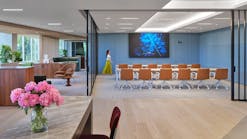LEDs Magazine has spotlighted some of the best and brightest in the North American lighting industry with the publication’s “40 Under 40” issue. As a nonprofit whose work touches so many aspects of the industry, the DesignLights Consortium (DLC) congratulates these young professionals who have already achieved so much and we look forward to their future contributions.
With so much career still ahead of them, I expect that we will hear again from and about the 2020 40 Under 40 honorees, as each continues to contribute to advances and innovation in the solid-state lighting (SSL) industry. I hope, too, that each will recognize that the work we need to do as an industry extends beyond better technology and products. Namely, we are in dire need of diversity in our ranks.
While the homogeneity of this year’s awardees was not lost on me, I realize that this largely reflects the overall face of the lighting industry. As an employer, I am well aware of how many of lighting professionals share the same colleges and universities, the same career paths, even the same geographies. Over the years, lighting conferences have traditionally been — and continue to be — primarily gatherings of white men, both as attendees and panelists.
For the good of our industry (not to mention just the overall good), we cannot accept that this is who we are and convince ourselves we are doing the best we can. Clearly, we are not, as our diversity is not expanding with new, young professionals. It’s imperative for today’s lighting industry leaders to start not just introducing but welcoming young people of color and young women of all races to the many possibilities this sector has to offer.
The SSL industry is, of course, not alone in lacking diversity. It is a challenge plaguing technology professions across the board. A US Equal Employment Opportunity Commission (EEOC) special report on Diversity in High Tech concluded that “despite rapid transformation in the field, the overwhelming dominance of white men in the industries and occupations associated with technology remained.” Compared with overall private industry, the report found that the high-technology sector employed a smaller percentage of Blacks, Hispanics, and women — “concerning trends,” the authors wrote. (View the report at https://bit.ly/2Y2Ces3.)
The EEOC report also found that “over time, over half of highly qualified women working in science, engineering, and technology companies quit their jobs” and attributed this disturbing statistic to a combination of factors including inhospitable work cultures, feelings of isolation, and lack of advancement for women. Two-thirds of women — and three-quarters of Black women — surveyed reported “having to prove themselves over and over, their success discounted and their expertise questioned.”
A newly-formed coalition of about 60 technology companies based in Massachusetts recently announced a goal to double the percentage of Black and Latino workers in tech jobs in Massachusetts by 2030. The group is led by the Mass Technology Leadership Council, which released a report in January highlighting the issue in Massachusetts, where only about 5% of people working in technology are Black and approximately 7% are Hispanic or Latino. By comparison, the city of Boston — the state’s hub for technology companies, academic institutions, and incubators — has a population that is 25.3% Black and 19.7% Latino, according to US Census Bureau 2019 population estimates (available at https://bit.ly/2FmUG8d). While these kinds of statistics are disappointing, they don’t surprise us — and that emphasizes the problem: They should not be an acceptable norm.
The lighting industry can lead the way to reverse course on these trends. Lighting serves everyone. It is ubiquitous, serving the practical needs of people living and working everywhere — from schools, daycare centers, and hospitals to high-rise office buildings, banks, and retail spaces. The capabilities of lighting extend from human health and wellness, energy solutions, and plant growth to IoT applications across buildings and streetscapes.
Imagine if the lighting industry looked as diverse as the people who use its products. What design innovations, marketing strategies, networking opportunities, and more are we missing because of the lack of representation? How might we advance the development of smart buildings and smart cities by diversifying our industry?
As young lighting leaders, the 40 Under 40 honorees have an opportunity to breach this chasm between industry and rest-of-the-world demographics. Big change often starts out small — steps like sharing knowledge with younger people, bringing up the subject of diversity during office meetings, and recruiting interns and employees from outside the company’s usual go-to talent pool.
During the International Association of Lighting Designers’ June “Impacts of Racism in the Lighting Industry” webinar, Bartholomew Lighting principal Edward Bartholomew explained, “There are ways that prevent people — who may not look like you, who may not come from the same schools, who may not run in the same social circles as you — from joining a practice…Companies need to be able to recruit and retain a thriving, diverse workforce that leaders and customers want and need.”
A Boston Globe story about the new Mass Technology Leadership Council effort noted that its success will hinge on whether technology company leaders treat inclusion improvement goals “the same way as other business goals, and hold managers and team leaders accountable for falling short.”
That’s good advice for the lighting industry as well. By elevating equity and inclusion as top-level objectives, we stand to make the industry more innovative, stronger, and sustainable as we tackle the opportunities and challenges ahead.
Get to know our expert
CHRISTINA HALFPENNY is executive director and CEO of the DesignLights Consortium, responsible for strategic planning, stakeholder engagement and collaboration, and improvement in business systems for the nonprofit.
For up-to-the-minute LED and SSL updates, why not follow us on Twitter? You’ll find curated content and commentary, as well as information on industry events, webcasts, and surveys on our LinkedIn Company Page and our Facebook page.






